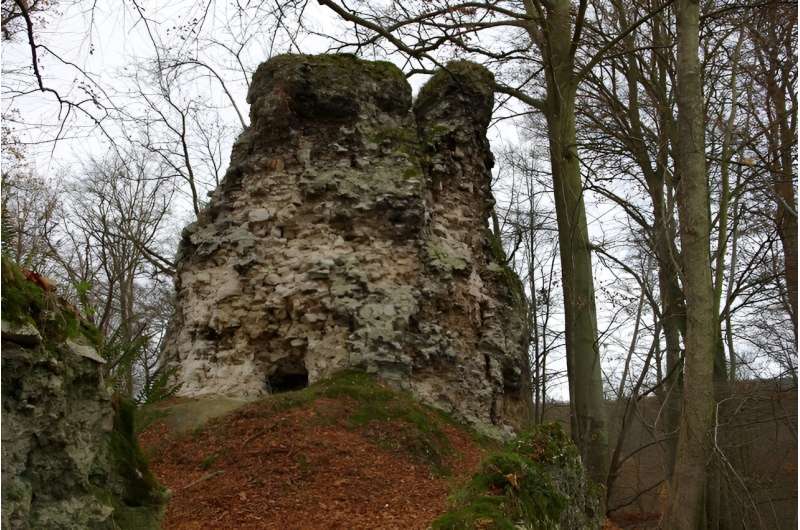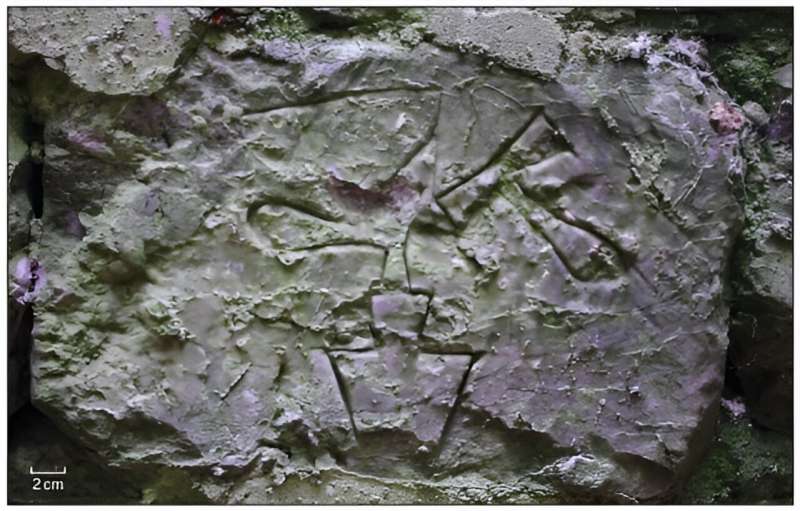This article has been reviewed according to Science X's editorial process and policies. Editors have highlighted the following attributes while ensuring the content's credibility:
fact-checked
proofread
Examining late medieval to early modern stone engravings created by prisoners in a castle dungeon

Castles served to enforce law and order during the Middle Ages and the early modern era. Often, they had facilities to hold people captive. The Questenburg near Sangerhausen (Mansfeld-Südharz district) was probably built in the middle of the 13th century. In the basement of its tower, someone has immortalized themselves with numerous stone engravings.
Among them are tools, agricultural implements, everyday objects, Christian, heraldic or magical symbols, geometric shapes, sexual images and scenic representations. The latter include perhaps deeply symbolic images such as a composition of a lock and a key.
During the Middle Ages and early modern times, castles served to enforce law and order. Their masters usually held at least lower jurisdiction. They also exercised military power in feuds and other military conflicts. In both contexts, prisoners could be taken. At times, the abduction of people for the purpose of extorting ransom could even be a source of income, especially in the later phases of the Middle Ages.
Accordingly, castles often had facilities to hold people captive. These dungeons are often found in the basements of keeps or other towers, which frequently had basements only accessible through an opening in the ceiling. Windowless, deep, dark and barely visible from above through the "fear hole," such dungeons are now one of the eerie attractions of many castles open to tourists.
The Questenburg near Sangerhausen (Mansfeld-Südharz district) was probably built in the middle of the 13th century by the counts of Beichlingen-Rothenburg. Today the fortification is preserved as a quaint castle ruin in a commanding position above a valley. In the elongated main or upper castle are the ruins of the palace, some adjacent buildings and the round stump of the keep, which has largely been stripped of its outer shells by stone quarrying.
The tower covered the fortification from attacks from the northwest, deep trenches dug into the rock provided further protection. To the south-west below the main castle there is a walled outer bailey and another terrace, probably also included in the fortification complex. In front of this area no stone buildings are visible, probably constructions made of wood were located there. The building material was otherwise predominantly a light gray, quite soft dolomite limestone or gypsum.

In the round basement of about 3.2 m diameter of the now roofless but still a good 7 m high tower, someone has immortalized themselves with numerous engravings. The insides of the soft, rather roughly mortared limestone blocks served as the canvas. While more than 70 depictions were still visible in the 1920s, a new recording has revealed about 60 different depictions.
Stylistically, most of them can be assigned to one person, and in a smaller number of depictions, a second and third prisoner can be identified, concludes Prof. Dr. Felix Biermann, who has now published the representations in the current volume of the journal Jahresschrift für Mitteldeutsche Vorgeschichte (in German).
The graffiti must have been created in the late Middle Ages or the earliest modern period, because the tools depicted can be dated to that era based on their style. The images include craftsmen's tools, agricultural implements, everyday objects, Christian, heraldic or magical symbols, geometric shapes, sexual imagery and scenic representations. The latter include, for example, hammers striking an anvil and—perhaps deeply symbolic—compositions such as a lock and key.
The graffiti starts about 0.5 m above the current base of the tower. Since not a single engraving was made deeper, the lower parts of the room were probably covered by a filling at that time—rubble or rubbish, an eloquent testimony to the circumstances under which the prisoners were incarcerated.
More information: Felix Biermann, Botschaften aus Burgverliesen—spätmittelalterlich-frühneuzeitliche Ritzzeichnungen in Questenberg (Harz) und Greiffenberg (Uckermark), Jahresschrift für mitteldeutsche Vorgeschichte (2023). DOI: 10.11588/jsmv.2023.1.100718
Provided by Landesmuseum für Vorgeschichte





















